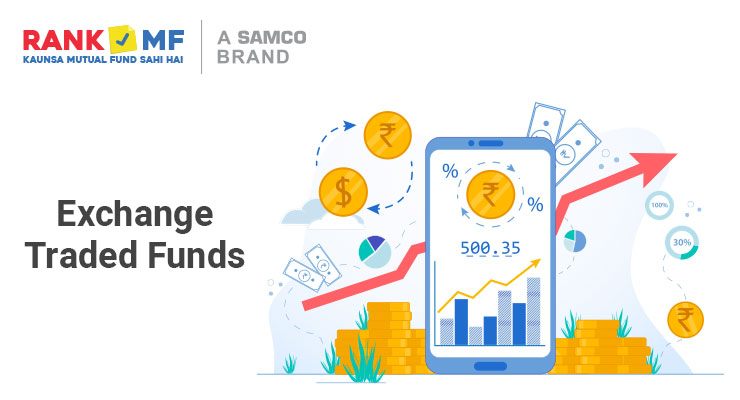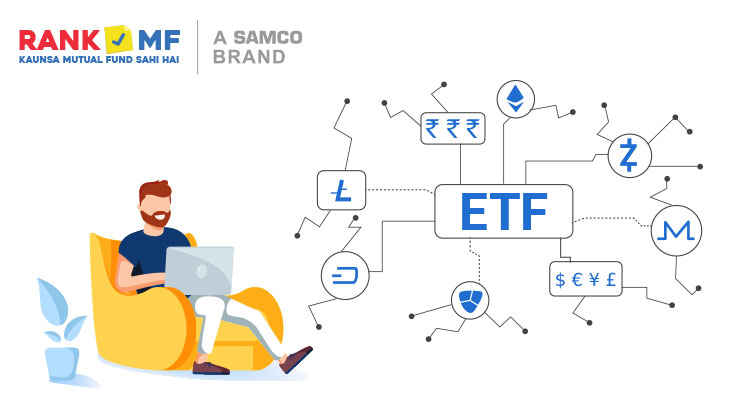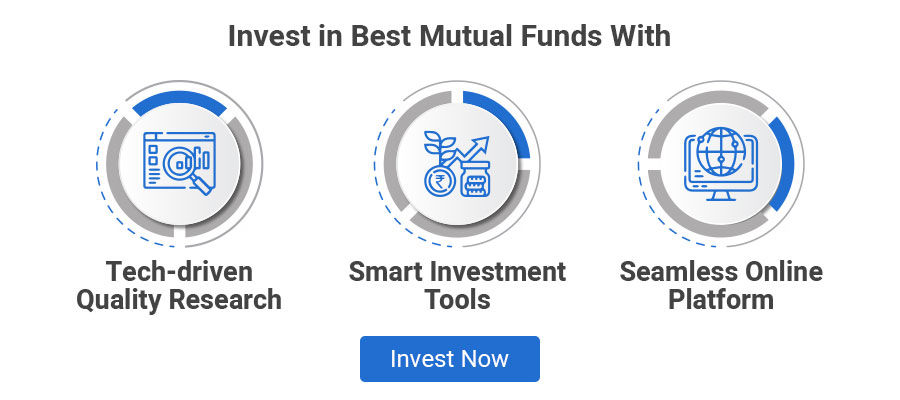The last one year has been great for exchange traded funds or ETFs. Bank ETFs have performed exceptionally well. Nippon India ETF PSU Bank BeES is one of the best ETFs in 2021 as it has generated a one-year return of 93.44%. This is much higher than the returns generated by popular actively managed mutual funds.
Before you jump on the ETF bandwagon, lets first understand what is an exchange traded fund? How does an ETF work and how to select best ETFs for investments? In the end, we will also share a list of the 10 best ETFs in 2021.
In this article, we will cover:
What are Exchange Traded Funds?
Exchange Traded Funds or ETF is a collection or basket of securities which tracks the performance of its benchmark index. This benchmark index can be BSE Sensex, Nifty 50, S&P BSE Banks etc. The unique selling point (USP) of ETFs is the fact that it can be traded on stock exchanges on real-time basis like equity shares. Yes, you can actually buy ETFs in the morning and sell them during the trading hours to capitalise on intraday opportunities.
ETFs were first introduced on the American Stock Exchange & the Philadelphia Stock Exchange in 1989. But it was more than a decade later that they made an entry in the Indian markets. Nifty BeEs is the first exchange traded fund which was launched in India in 2001. Its aim is to give investors a cost-effective and convenient method to invest in all the 50 nifty stocks collectively.
For example, say you wanted to invest in all the 50 stocks which make up Nifty 50 index. Without ETFs, you have two options –
- Buy each of the 50 stocks separately. Considering the share price as on 30th September 2021, you will have to shell out Rs 1,53,678.
- Invest in futures and options contract with Nifty 50 as the underlying asset.
Now both these options have issues. In option one, you might not have Rs 1.5 lakhs for trading. While in option two, you might not understand the technicalities of F&O market. This is where ETFs come to investor’s rescue. You can get exposure to all the 50 stocks that make up Nifty 50 index at just a fraction of the cost with ETFs. You can simply invest in Nifty BeEs which has a net asset value of Rs 189.16. This way you get to mirror the performance of Nifty without shelling out Rs 1.53 Lakhs.
Watch this video to learn what is an ETF and how ETFs work.
Types of Exchange Traded Funds
Exchange traded fund is not just a collection of stocks. It can be based on any underlying asset. The three basic types of ETFs in India are –
1. Equity ETFs is a collection of equity stocks. This is further divided based on the sector that it tracks. For example:
- Tata Nifty Private Bank exchange traded fund invests in shares of private banks and tracks Nifty Private Bank index.
- HDFC Sensex ETF invests in the same 30 companies in the exact same proportion as BSE Sensex.
2. Debt ETFs is a basket containing fixed income instruments like corporate bonds, government bonds, treasury bills etc.
- Liquid BeEs purely invests in government securities, treasury bills, repo and reverse repo rate instruments etc. Its benchmark index is Nifty 1D rate index.
- Bharat Bond ETF is India’s first pure debt exchange traded fund. It invests in bonds of central public sector enterprises (CPSEs).
3. Commodity ETFs have commodities like gold as the underlying asset. It helps you take part in gold’s price movements without actually owning physical gold. Recently, the Securities and Exchange Board of India (SEBI) has allowed mutual fund houses to set up silver exchange traded funds.
- Axis Gold ETF tracks the movement of physical gold.
- Nippon India ETF Gold BeEs is also a popular commodity ETF which also tracks the price movement of physical gold.
How Does an ETF Work?
To understand how an ETF works, you first need to understand how a mutual fund works. When you invest in mutual funds, you are dealing with an asset management company (AMC). Their job is to collect funds from various investors and use this pool of money to buy actual shares of companies.
These shares belong to the mutual fund scheme and unitholders but are kept with a custodian. Now, to sell your units, you approach the fund house. In this entire transaction, you are interacting with the fund house and not the company whose shares you hold. So, when you are investing in mutual funds, you can be guaranteed that there is a counterparty who will buy when you want to sell your shares.
This is where ETFs are slightly different. Since ETFs are traded on a stock exchange on real-time basis, the buying and selling is dependent on market liquidity. You will be able to sell your units only if you find a suitable counterparty.
Another fundamental difference between exchange traded funds and mutual funds is the method of price-discovery. When you invest in a mutual fund, units are allotted as per the fund’s closing net asset value (NAV). This NAV is declared at the end of the trading day and is same for all the investors, irrespective of whether you invest Rs 1,000 or Rs 10 Lakhs.
But in case of exchange traded funds, the price discovery is on a real time basis. So, different investors can purchase ETF units at different prices. Let us now look at the advantages and disadvantages of ETFs.
5 Important Advantages of ETF – Pros of Exchange Traded Funds:
1. ETFs provide diversification to investors: When you invest in ETFs, you are buying an entire collection or basket of stocks. This helps you achieve better diversification as losses in a few stocks are offset against gains in other stocks.
For example – Suppose you invest in ICICI Prudential Healthcare exchange traded fund. While your friend picks five stocks from this ETF and invests in them individually. If three of these five stocks fall, then your friend’s overall loss will be high. But since you invested in the entire basket via the exchange traded fund, your losses are diversified and offset to some extent. So, an important advantage of ETF is that they offer higher diversification and reduce overall risk compared to individual stocks.
2. Low cost to Investors: Majority of the ETFs are passively managed. This helps investors save up on fund management fees in the form of lower expense ratios. For example – Nifty BeEs and HDFC Index Fund – Nifty 50 Plan invest in the same 50 stocks. But the expense ratio of Nifty BeEs is 0.05% whereas the expense ratio of HDFC Index Fund – Nifty 50 Plan is 0.40%. So, a key advantage of ETFs is that they are highly cost-effective.
3. ETFs offer Flexibility: ETFs offer good exposure to different asset classes and sectors. This helps investors design the portfolio without much hassle.
4. ETF’s are Transparent: When it comes to Index ETFs, constituents of the exchange traded fund is normally available in the public domain as it is mandated by SEBI. So, ETF investors are always aware of exactly where the fund is invested.
5. ETF allows intraday trading: This is one of the biggest advantages of ETFs. In mutual funds NAV is declared at the end of the day. But in the case of ETFs, you can actually buy and sell on real time basis. For example, suppose the market fell 500 points around 12 pm. But by 3.30 pm, the market closed 200 points up.
In mutual funds, your NAV will be calculated at the closing price i.e. when market was 200 points up. But in case of exchange traded fund, you can actually buy units at 12 pm and sell them by 3.30 pm at an intraday profit. This is a unique advantage of ETFs. You can also place limit orders, stop-loss etc. in ETFs, just like when trading shares.
Disadvantages of ETFs – Cons of Exchange Traded Funds:
1. Low Trading Volumes: Except for a few popular ones, most of the ETFs in India have very low trading volumes. For example –
- The daily trading volume of CPSE ETF is 24,63,188 shares.
- Whereas the daily trading volume of HDFC Nifty exchange traded fund is 1,016 shares.
Such low liquidity kills any intraday opportunity as investors might face issues in exiting the ETF. Another problem with low liquidity is that it leads to a high bid-ask spread which reduces the effectiveness of buying funds at the exchange.
2. Misuse in the Short-Term: Mutual Funds are usually thought to be long-term investment instruments. With the introduction of ETFs, traders develop a tendency of continuous trading in ETFs. This intraday trading mindset may impact your long-term investments.
3. Transaction Costs: An exchange traded fund is exactly like a share. So, whenever you buy and sell ETFs you have to pay securities transaction tax (STT) and hefty brokerages. The more buying and selling you do, the more taxes and brokerages you pay. While you cannot avoid taxes, you can avoid paying high brokerages by trading with Samco Securities. Samco is one of the best discount brokers in India with brokerage as low as 0.02% or Rs 20, whichever is low, per executed order.
Let us quickly take a look at the key differences between ETFs and Mutual Funds.
Exchange Traded Funds vs Mutual Funds:
| Key Pointers | Exchange Traded Funds | Mutual Funds |
| Definition | ETFs are a basket of stocks which are traded on the stock exchange. | Mutual fund is an investment vehicle which pools funds from various investors and invests in stocks as per the fund’s investment objective. |
| Pricing | ETFs are traded at market price. | Mutual Funds are traded at closing NAV for a particular day. |
| Expenses | ETFs have low operating expenses as they are passively managed. | Mutual Funds have higher operating expenses as fund management fees have to be paid. |
| Minimum Investment | There is no minimum value specified for ETFs. But investors need to buy at least 1 unit of any ETF. | The minimum investment amount in mutual fund varies from Rs 100 to Rs 500. |
| Trading Timings | ETFs can be purchased at any time during market hours. | There are predefined timings before which an investor needs to place an order to get the same day’s NAV. |
| Transaction cost | There is an additional impact cost, which may come in the form of high bid-ask spread. | There is no transaction cost compared to ETFs. |
| Loads | There is no entry or exit loads for ETFs. This makes it easy for investors to buy or sell the investments quickly. | Entry load in mutual funds has been banned by SEBI. But mutual funds do charge exit load on premature withdrawals. |
| Lock-in Period | ETFs do not have lock-in period. | Depending on the type of funds, there is a lock-in period. For example, Equity Linked Savings Scheme (ELSS) has a three-year lock-in period. |
| Demat Account | A demat account is compulsory to invest in ETFs. | You can invest in mutual funds without a Demat account. |
How to identify a Good ETF for investment purposes?
When buying shares, investors study the fundamentals of the company. They might conduct top-down or bottom-up investment approach to selecting stocks. Whereas in mutual funds, investors pass this responsibility to the fund managers.
[Read More: How to Select Best Mutual Funds]
Like mutual funds, investors have no control on the underlying portfolio of an exchange traded fund. But still, there are certain things that investors must consider while selecting best ETFs.
1. Liquidity & Average Daily Volume: Liquidity is an important parameter when selecting best ETFs for investment. Liquidity decides the ease with which you can enter and exit an exchange traded fund. Even the size of your investment is dependent on liquidity. Best ETFs are those that have high trading volumes and low bid-ask spreads. It is recommended that investors must check the average daily trading volume of ETFs before investing.
2. Tracking Error: This is the difference between the returns generated by the exchange traded fund and its benchmark. Best ETFs are ones which have very low tracking error. Remember, the lower the tracking error, the better is the ETF’s performance. If there is a significant deviation in the performance of the exchange traded fund and the benchmark, then it’s better to avoid that exchange traded fund.
3. Expense ratio: The expense ratio of a fund covers the cost of running the fund. This includes paying the fund manager’s salary, operational and legal costs etc. All this comes out of the investors pocket as it is deducted from the fund’s NAV. Since equity mutual funds are actively managed, their expense ratios are high. But being passively managed, ETFs have very low expense ratios. This directly increases an investor’s portfolio returns.
4. Impact Cost: When investing in ETFs, you need to worry about the total cost of ownership. This includes the TER, brokerage and bid-ask spread. Higher the bid-ask spread; the higher will be the impact on the investor. A wide bid-ask spread could be due to low liquidity. Best ETFs are the ones which have very low impact cost.
Let us now look at the 10 best performing ETFs in 2021 as per last one-year return.
10 Best ETFs in 2021 – Best Exchange Traded Funds in 2021
| Top Performing ETFs | NAV | Assets (Rs. cr.) | 1-year return | 2-year return | 3-year return |
| Nippon India ETF PSU Bank BeES | 26.9 | 278.74 | 93.44 | 3.55 | -3.27 |
| Kotak PSU Bank ETF | 243 | 137.38 | 93.02 | 3.31 | -3.47 |
| CPSE Exchange Traded Fund | 30.52 | 9,854.40 | 85.52 | 13.1 | 4.66 |
| Motilal MOSt Oswal Midcap 100 ETF | 31.99 | 58.92 | 79.59 | 38.06 | 21.57 |
| Edelweiss ETF – Nifty Bank | 4,000.10 | 1.1 | 75.01 | 13.06 | 14.11 |
| SBI – ETF Nifty Bank | 371.76 | 4,257.91 | 74.79 | 12.65 | 13.79 |
| Nippon India ETF Bank BeES | 374.81 | 8,257.10 | 74.72 | 12.6 | 13.75 |
| Kotak Bank ETF | 376.34 | 7,281.20 | 74.58 | 12.49 | 13.69 |
| Kotak NV 20 ETF | 98.06 | 23.22 | 66.5 | 31.29 | 20.96 |
| ICICI Prudential NV20 ETF | 96.41 | 16.88 | 66.46 | 31.38 | 21.02 |
*Returns as on 30th September 2021. **To check the latest data and ranking of all ETFs click here.
The unique structure of ETFs attracts and works for all types of investors – retail, institutional, long-term or short-term investors. exchange traded funds allow long-term investors to diversify their portfolio at one shot at low cost. And it gives liquidity to traders for capitalising on intraday opportunities. To invest or trade in best ETFs in 2021, open a FREE Samco demat account today.
But if you are worried about limited liquidity and are a purely long-term investor, then you can invest in index funds, which are an extension of ETFs. To invest in best index funds in 2021, open a FREE RankMF account today!






Leave A Comment?